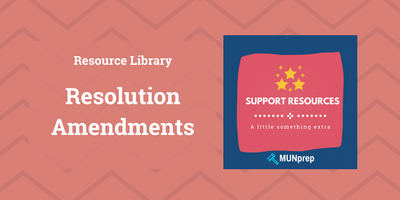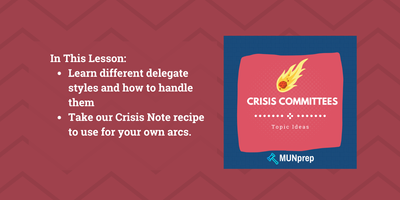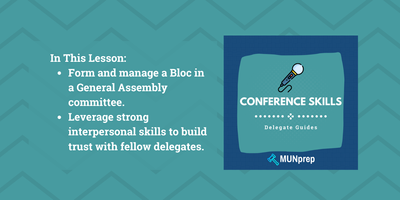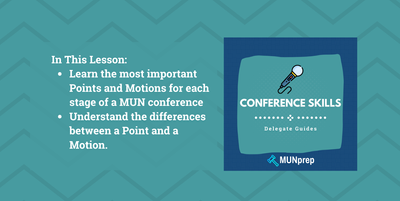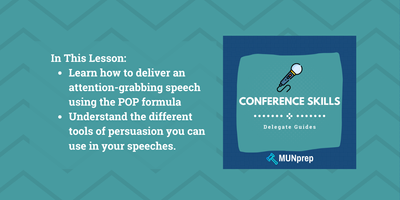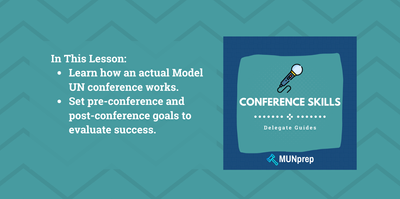MUN Resolutions – Everything you need to know
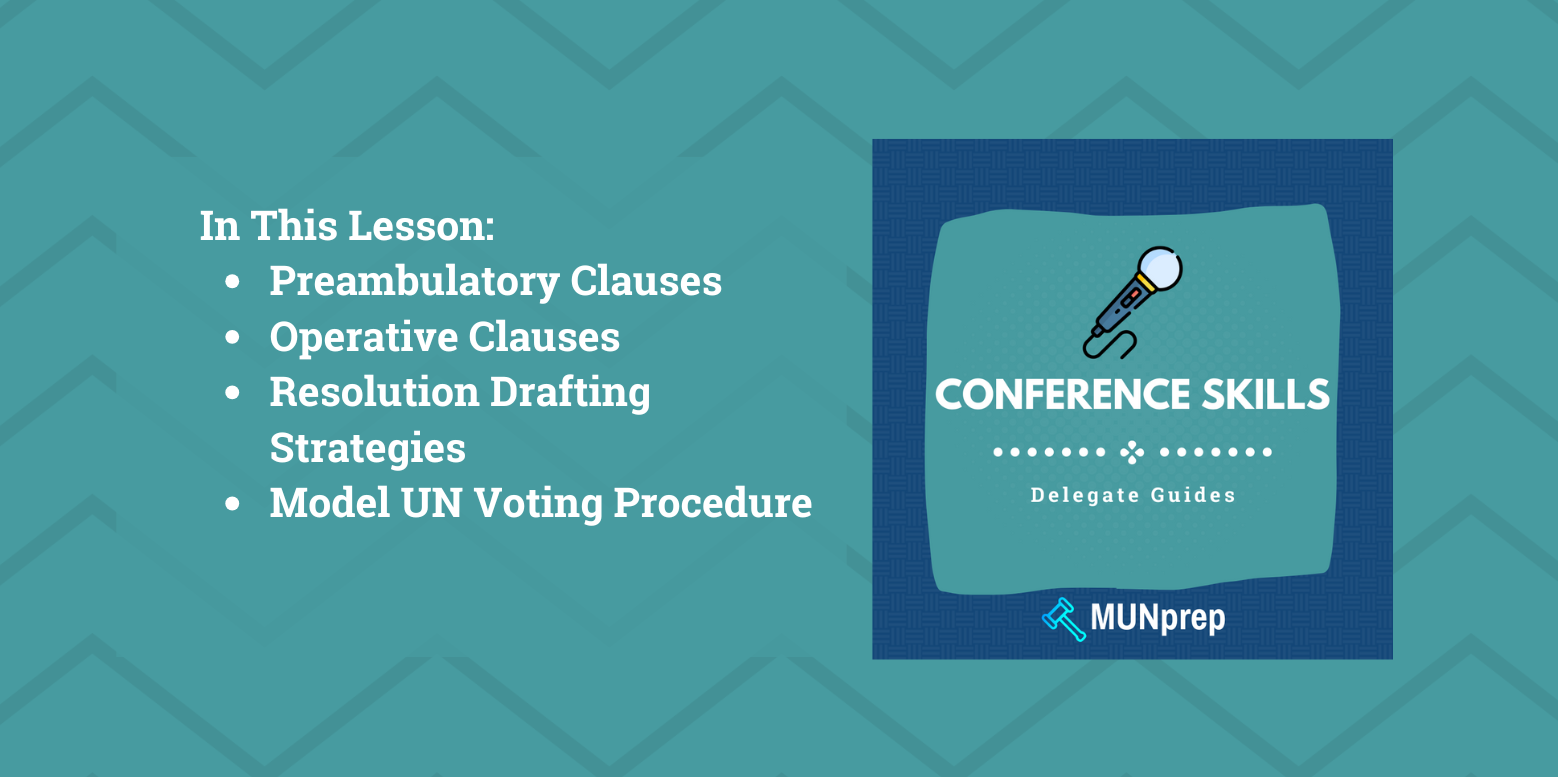
MUN Resolutions
Every delegate wants to sponsor a resolution and see it get passed. It’s a great indicator of the general consensus of the committee, and in many cases, it shows that you were able to create and market a resolution better than anyone else. Today, we’re going to teach you all about Resolutions & Directives – What they are, how they work, and what to include.
To start, we’re going to highlight some of the basics of Resolutions. With the help of some Resolution examples and templates, we’re going to show you everything you need to consider and help you to write the best Resolution possible!
Getting started with Resolutions
A Resolution is a legal document that expresses the general opinion of the committee. Once passed it can be seen as a list of actions that your committee recommends.
At its core, a Resolution is a collection of Clauses that all have the job of helping you to describe your solutions – they act as the building blocks of your resolution. Some clauses (Preambulatory Clauses) help you to outline the general problems that your resolution will fix, whereas others (Operative Clauses) help you to display your solutions in an organized and easily understandable way.
The Birth of a Resolution – from Word documents to a Ratified agreement.
As you might imagine, crafting a quality Resolution can take a bit of time. Obviously, the Chair can’t just bang their gavel and magically convert your work into a Resolution. You need to go through a process of drafting, presenting, refining, and voting before you can come up with a finished document.
This chart can help you with the general idea:

A Resolution takes many forms before it becomes the final product. At first, it starts as a Working Paper, but the moment it gets submitted to the Dais it becomes a Draft Resolution. Over time, you will work with the rest of your committee through Moderated and Unmoderated Caucuses to improve and perfect your Draft Resolutions. Delegates might also suggest amendments, these adjustments can provide useful fixes and secure more votes.
Eventually, after you’ve done all that you can, your document will be put to a vote. If it passes, it becomes a proper Resolution, and the terms of the document are seen as the official opinions of that UN committee. If you’re on the Security Council, this means that the Resolution would be a legally binding document in International Law.
Structuring your resolution - 3 Stages
At this point, you should understand a bit about the process of creating a resolution and what these documents are supposed to accomplish. Next, we’re going to look at how you can draft your own Resolution and some of the key ingredients to include.
While your Resolution might be anywhere from 5 to 50 pages long, it’s always going to have a lot of the same core components. Specifically, you need an Introduction, Preambulatory Clauses, and Operative Clauses.
It should look something like this:

1 - Resolution Introduction – Sponsors & Signatories
To start, you will need a Title, Committee topic, and a list of Sponsors and Signatories.
Since a Resolution requires contributions from multiple delegates, you need to have a way of giving people credit for the work that they do. This is where the Sponsors and Signatories come in.
A Sponsor is someone who made a significant contribution to the resolution writing process. They had some of the key ideas and worked with the other sponsors to create a resolution.
In contrast, Signatories are people who may simply be supportive of your ideas or believe that a Resolution is significant enough to submit to the dais for debate. Getting Signatories for a Resolution is a rather straightforward process as most delegates will reciprocally sign each other’s resolutions. It’s important to remember that you can be a Signatory and still vote against a resolution.
2 - Preambulatory clauses
A Preambulatory Clause is a precursor to the rest of your Resolution, it’s basically an acknowledgement of the problem that you are attempting to solve. You can use a Preambulatory Clause to highlight the magnitude of certain aspects of the issue that you will attempt to fix later on in your document. You can also use them to appeal to certain principles, define key terms or discuss the general scope of a topic that you are solving.
All Preambulatory clauses end with a semicolon (;).
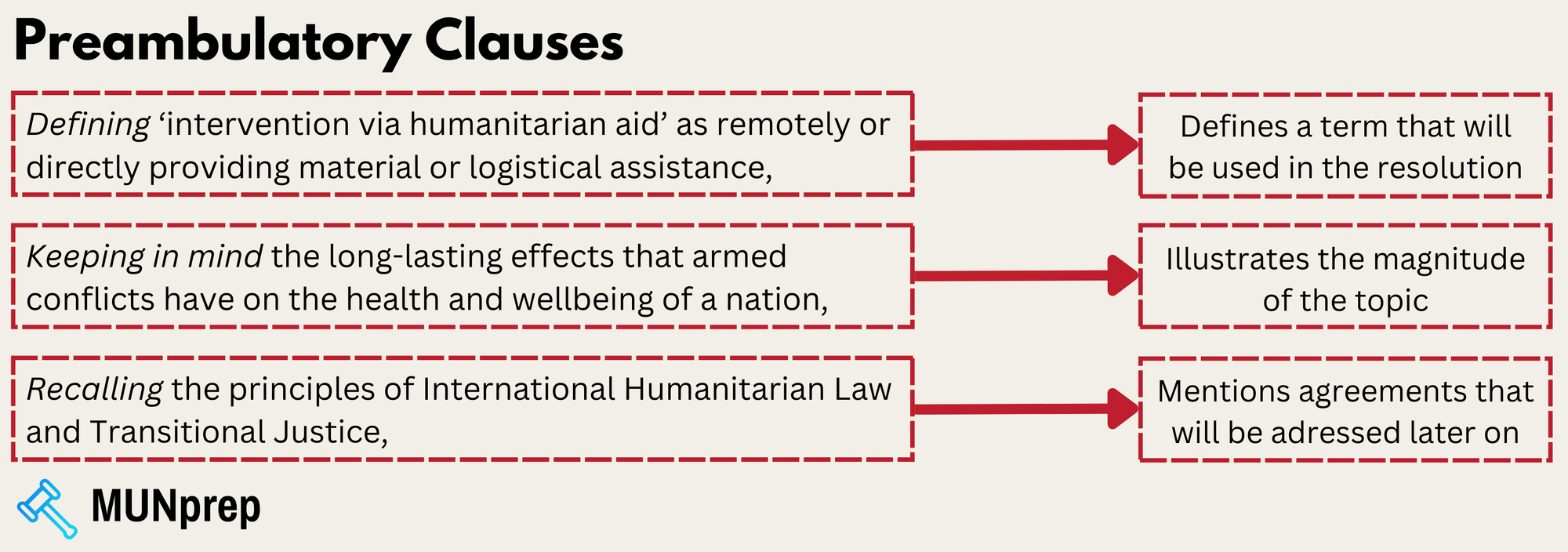
Different Types of Preambulatory Clause:
Here are some examples of Preambulatory Clause terms:
- Affirming
- Declaring
- Further deploring
- Realizing
- Alarmed by
- Deeply Concerned
- Having adopted
- Reaffirming
- Approving
- Deeply Convinced
- Having considered
- Recalling
- Aware of
- Desiring
- Having devoted attention
- Recognizing
- Believing
- Emphasizing
- Having examined
- Referring
- Bearing in mind
3 - Operative Clauses
An Operative Clause is your opportunity to showcase the solutions that you have created for your committee. Generally, writing these clauses should take up most of your time and make up most of your resolution. It’s also important to make them as detailed as possible.
Each Operative Clauses should end with a comma (,) the final clause should be punctuated with a full stop(.).
How to write an operative clause:
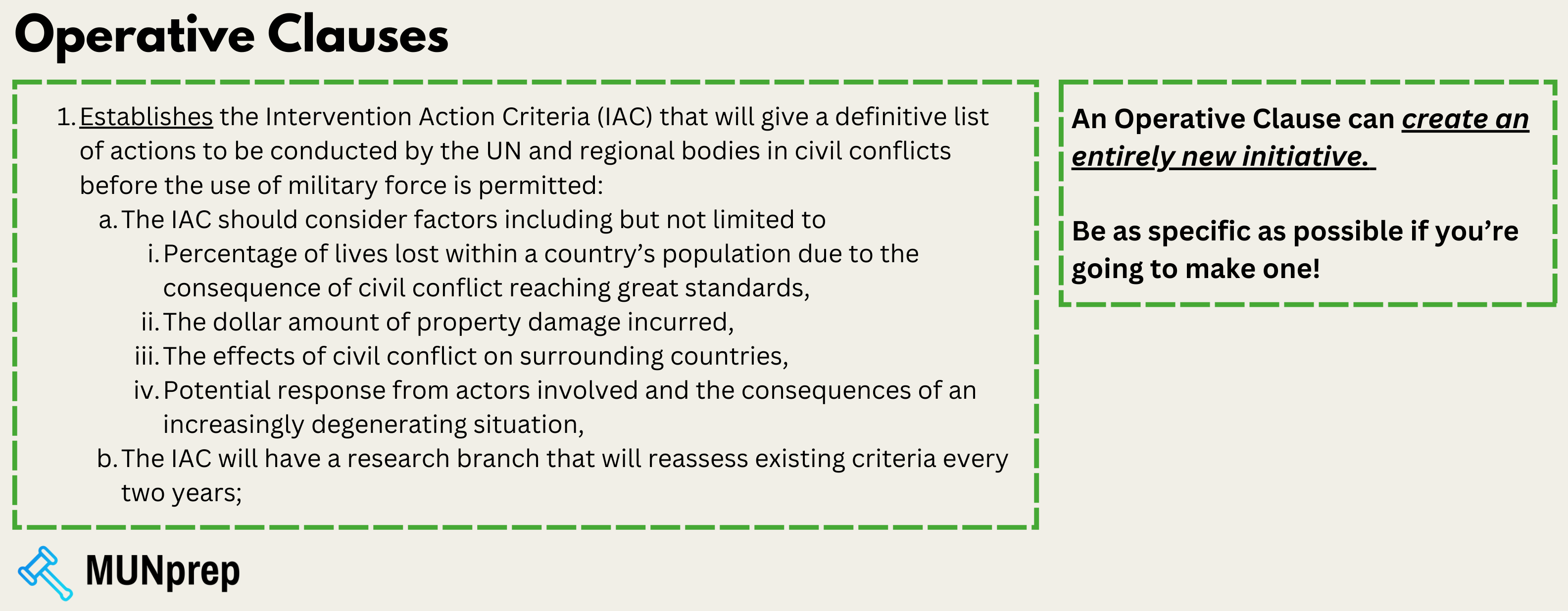
Different Types of Operative Clause
Example: "Encourages the creation of a global task force to monitor plastic pollution in oceans."
Example: "Recommends enhancing the capacity of the Paris Agreement's enforcement mechanisms."
Example: "Requests the allocation of $50 million to support education in underprivileged areas."
Example: "Establishes international standards for carbon emissions in industrial manufacturing."
Example: "Urges Member States to collaborate on the exchange of renewable energy technologies."
Example: "Requests Member States to submit annual progress reports on clean water initiatives."
Example: "Calls upon international organizations to provide training for disaster response teams."
Example: "Supports public awareness campaigns to reduce single-use plastic consumption."
These are some terms that you can use to start your Operative Clauses:
- Accepts
- Considers
- Further invites
- Requests
- Affirms
- Declares
- Further recommends
- Requires
- Approves
- Demands
- Further requests
- Strongly affirms
- Authorizes
- Deplores
- Notes
- Strongly condemns
- Calls
- Designates
- Proclaims
Drafting your resolution
Following the structure for Resolutions is necessary, but knowing what to put in your Clauses is just as important – a perfectly formatted Resolution won’t get passed unless it also provides innovative solutions.
In creating these solutions, you can bring up any topic and create any initiative you want as long as it works to solve the Committee topic. You can approach the topic in any way that you see fit. This means that the content of a Resolution can take many different forms.
You could write a detailed document that considers a specific aspect of the problem. You could also take a more general approach and look at a number of solutions – this might include improving existing practices or coming up with a new plan that revolutionizes the way in which an issue is approached.
Regardless of how you approach the topic, it is always more important that your solutions are well thought out – no matter how far-fetched.
With resolution writing, you should always try to include as much detail as you can possible – the more information the better. This is because you want to convince delegates that you provide the best and most well thought out solutions for your Committee. More detail can help you do that. For example, you could provide logical funding mechanisms and show a basic breakdown of expenses. You could also make a list of supplies and explain how they would be used.

FormatReso - Resolution Formatting Tool
FormatReso is the best place for you to write your MUN resolutions! They will:
- Guide you through writing the content of your resolution
- Automatically format your resolution (note that formatting requirements can vary from conference to conference)
- Allow you to download your resolution into a word processor.
Planning a Barbecue
Writing a Clause about an unfamiliar topic can make the entire Resolution writing process seem a lot more daunting. So it’s important to always go back to basics, sometimes it’s best to think about something more familiar – like an invitation. Today, we’re going to be planning a barbecue.
The invitation might look something like this:

Just like with any quality invitation, Stanley made sure to include:
1 – The location
2 – The time
3 – How many people are invited
4 – What guests could bring
5 – How guests can get to the event
Overall, these are the types of things that you should consider with your own Resolutions and they can translate to other committee types. For example, if you were trying to write a clause to set up a new Refugee camp, some things that you might include would be:
1 – Camp location
2 – How long will the camp be needed
3 – How many people can live at this camp
4 – How will you provide supplies
5 – Who is responsible for funding
As you can see, the considerations are very similar, and the more situations that you factor in, the better your Resolution is going to be. Once you have all of your ideas pieced together, you can start making a proper resolution. What makes this even easier is now that you know the basics, you can pretty much make an Operative Clause out of anything.
For example, if Stanley wanted to make one out of his invitation, it would look something like this:

And if Stanley wanted to make a resolution to pass in a MUN committee, he might do something like this:


Improvising with your Resolution
While it is important to have factual accuracy with your position paper, it is not always the same for resolutions.
For example, it is not expected for MUN delegates to know how much one of their initiatives might cost.
In these cases, made-up statistics and details can actually help you, especially if you show that you have taken the time to consider a number of different possibilities. Ballpark estimates for certain things can actually help you - It shows that you have taken the time to consider a number of different possibilities.
When coming up with extra detail for your Resolution, all you have to do is be able to fill in the gaps with something that makes sense. For example, you cant expect the construction of a new Battleship to only cost twenty dollars. But as long as you throw in a rough estimate for your budget, you can pitch that to your committee and it can become another feature of your resolution.
A Quick Recap – Some things to remember
Here are some of the essentials to remember about Resolution writing.
Sponsors - The main creators of your resolution.
Signatories - Someone who wants to see a resolution submitted for debate.
Preambulatory Clause - Use them to highlight important issues that you will solve later in your resolution.
Operative Clause - Use them to outline your solutions for a particular problem.
Punctuation - End preambulatory clauses with a semicolon.
End operative clauses with a comma, LAST operative clause with a full stop.
Ethics - Pre-writing clauses are not allowed at a MUN conference. You should only start writing your resolution when you’re in committee.
Table to summarize some of the basics of MUN resolutions
Consider checking out our guide on Points and motions for even more MUN basics!
The Next Steps: Getting your Resolution passed
Presenting and the Q&A Session
So by this point, you found your bloc, discussed your ideas, and put your clauses down on paper – you’re almost there. The next step is presenting your work to the rest of the committee. This is the time when you have a chance to compare your Resolution with the work of other delegates. It also helps to show the Chair who the primary drivers of a resolution are. If you have sponsored a Resolution, you should try to make sure that you are one of the delegates who is presenting it.
A Resolution presentation consists of a read-through of your entire resolution to the committee along with a Q&A period afterwards. It’s always a good idea to organize your bloc before you start your presentation. This means that you should decide which delegates are responsible for each section of the Resolution. This way, your bloc can efficiently answer any questions without too much confusion, it also makes your bloc seem much more cohesive.
You should also look out for other Resolutions that you may be able to merge with. A merge instantly increases the size of your bloc, can add more detail to your resolution, and may generally make it more likely that your work is going to pass. It also can help stop any overlap in solutions that exist with both papers, this may harm the prospects of both of them passing without a merge.
Curious about the Q&A Session? Check out our guide here
Amendments
After the presentation process, it’s time to discuss the content of the Resolution and convince other delegates to vote for you. The amendment process can help provide important last-minute adjustments to your paper, these may even convince delegates to vote for you. An amendment can include any sort of change to your Draft Resolution, such as adding or removing entire clauses or simple adjustments to them.
There are a few different parts of the amendment process and they work as follows:
- Friendly Amendment – a change that is supported by all sponsors of a Resolution, no vote is required to pass a friendly amendment.
- Unfriendly Amendment – a change that is not supported by all Resolution sponsors, requires a simple majority from the committee in order to pass.
Curious about amendments? Check out our guide here
Voting
The voting process is the culmination of all your hard work. You finally get to see how your resolution is going to compare with the others in your committee. This process includes a round of for and against speeches and then an official vote conducted by the Chair.
During this process, the committee room is ‘locked’ and motions will not be accepted until the voting process is complete. In some committees, you might only be able to pass 1 resolution – so it might important to make sure that your Draft Resolution gets voted on before any of the others.
The number of votes required to pass anything works according to a Quorum. This is the minimum number of delegates required to make decisions in a committee. This number is normally 1/3 to 1/2 of the committee present. A Quorum also applies to passing Motions and Resolutions. For a Resolution, the required number of signatories may also be related to the Quorum.
Directives
Directives are a special type of Resolution that are exclusive to Crisis committees. They are action-based documents that are meant to be produced quickly. They can be as short as a page long and may only require one Sponsor. Depending on various committee restrictions, delegates may combine directives to make a more comprehensive document.
The key to directives is efficiency, they are meant to handle a situation that is rapidly developing and is meant to deal with a very specific aspect of a problem. A Resolution will always take a more comprehensive approach to problem-solving. Directives require minimal discussion and each delegate should craft their Directive to make it suitable to their character in the committee.
Curious about Crisis Committees? Check out our guide here
Up next
You made it! By this point you should be a bona-fide pro on resolutions. Up next it's time to figure out exactly how you can stand out in your next committee, learn all the tips and tricks of experienced delegates to put yourself ahead of the pack.



